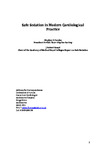Safe sedation in modern cardiological practice
| dc.contributor.author | Furniss, SS | |
| dc.contributor.author | Sneyd, John | |
| dc.date.accessioned | 2015-07-28T12:46:19Z | |
| dc.date.available | 2015-07-28T12:46:19Z | |
| dc.date.issued | 2015-10-01 | |
| dc.identifier.issn | 1355-6037 | |
| dc.identifier.issn | 1468-201X | |
| dc.identifier.uri | http://hdl.handle.net/10026.1/3467 | |
| dc.description | File replaced (incorrect version) on 18/7/22 by KT (LDS) (1.4) | |
| dc.description.abstract |
Safe sedation is fundamental to many modern cardiological procedures, and following the publication of the report on safe sedation by the Academy of Medical Royal Colleges, this report discusses sedation specifically in cardiological practice. The major areas within cardiology that use sedation are cardioversion, catheter ablation particularly of atrial fibrillation, transoesophageal echocardiography, implantable device (cardiovascular implantable electronic device) procedures and other procedures such as transcatheter aortic valve replacement. There is increasing demand for cardiological sedation but there is wide geographical variation in its use and there are also growing data to support non-anaesthetists giving sedation. The use of benzodiazepines, particularly for short procedures, is common, but even here good record-keeping and audit together with an understanding of the continuum of sedation and having appropriately trained staff and the necessary facilities are vital. Nurse administration of propofol may be appropriate for some procedures in cardiology that require at least moderate sedation. Appropriate training is essential and the use of capnography and target controlled infusion pumps for propofol administration is recommended. | |
| dc.format.extent | 1526-1530 | |
| dc.format.medium | Print-Electronic | |
| dc.language | en | |
| dc.language.iso | eng | |
| dc.publisher | BMJ | |
| dc.subject | Anesthesia Department, Hospital | |
| dc.subject | Cardiology | |
| dc.subject | Conscious Sedation | |
| dc.subject | Deep Sedation | |
| dc.subject | Guideline Adherence | |
| dc.subject | Humans | |
| dc.subject | Hypnotics and Sedatives | |
| dc.subject | Nurse Anesthetists | |
| dc.subject | Patient Safety | |
| dc.subject | Patient Selection | |
| dc.subject | Practice Guidelines as Topic | |
| dc.subject | Practice Patterns, Physicians' | |
| dc.subject | Risk Assessment | |
| dc.subject | Risk Factors | |
| dc.title | Safe sedation in modern cardiological practice | |
| dc.type | journal-article | |
| dc.type | Journal Article | |
| dc.type | Review | |
| plymouth.author-url | https://www.webofscience.com/api/gateway?GWVersion=2&SrcApp=PARTNER_APP&SrcAuth=LinksAMR&KeyUT=WOS:000361168800004&DestLinkType=FullRecord&DestApp=ALL_WOS&UsrCustomerID=11bb513d99f797142bcfeffcc58ea008 | |
| plymouth.issue | 19 | |
| plymouth.volume | 101 | |
| plymouth.publication-status | Published | |
| plymouth.journal | Heart | |
| dc.identifier.doi | 10.1136/heartjnl-2015-307656 | |
| plymouth.organisational-group | /Plymouth | |
| plymouth.organisational-group | /Plymouth/Faculty of Health | |
| plymouth.organisational-group | /Plymouth/Users by role | |
| dc.publisher.place | England | |
| dcterms.dateAccepted | 2015-05-28 | |
| dc.identifier.eissn | 1468-201X | |
| dc.rights.embargoperiod | Not known | |
| rioxxterms.versionofrecord | 10.1136/heartjnl-2015-307656 | |
| rioxxterms.licenseref.uri | http://www.rioxx.net/licenses/all-rights-reserved | |
| rioxxterms.licenseref.startdate | 2015-10 | |
| rioxxterms.type | Journal Article/Review |


